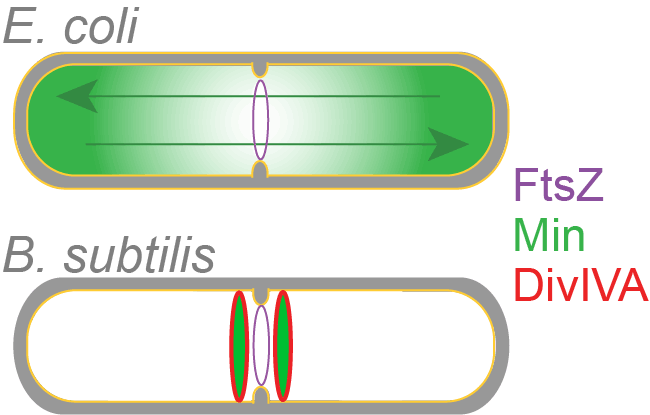Research
Regulation of cell division in Bacillus subtilis

Using Bacillus subtilis as a model organism, we are investigating how bacterial cells (without the help of a ruler) are able to divide symmetrically through binary fission. FtsZ is a tubulin-like protein that marks the division site in most bacteria by forming a ring-like structure called the Z-ring which then constricts along with a dozen other cell division proteins to form a division septum. Systems that positively or negatively influence Z-ring positioning are therefore of key interest. There are two well-known systems that negatively influence Z-ring assembly: (i) the nucleoid occlusion system in which a nucleoid-bound protein prevent Z-ring assembly until chromosome partitioning is complete; (ii) the Min system which inhibits Z-ring assembly close to poles in Escherichia coli.
We have shown that the function of Min system in B. subtilis is fundamentally different in comparison to that of E. coli. Unlike E. coli Min system, which prevents FtsZ ring assembly near cell poles, B. subtilis Min system is sequestered by DivIVA on either side of constricting Z-ring, to prevent subsequent assembly of aberrant Z-ring(s) at an adjacent site (Eswaramoorthy et al., mBio 2011). We are continuing our investigation to further understand how DivIVA activity is regulated during cell cycle. We are also in the process of discovering new cell division factors in B. subtilis and elucidating their mechanism of action (Brzozowski et al., Front. Microbiol. 2019). We have a general interest in studying how different antibiotics and other stress-inducing compounds affect cell division and cell wall synthesis.
We strongly believe that in addition to the use of model organisms to study fundamental biological processes such as cell division, studies involving non-model organisms are imperative to fulfill our aim of understanding different modes of reproduction in bacteria (Eswara and Ramamurthi, Annu. Rev. Microbiol. 2017). In that regard, we have projects focused on understanding cell division in spherical bacterium and an opportunistic pathogen Staphylococcus aureus (Eswara et al., eLife 2018).
The knowledge of different cell division proteins and their mechanisms of action could be harnessed to develop novel antimicrobial compounds to counter the threat posed by multi-drug resistant bacteria.